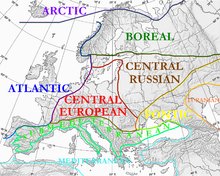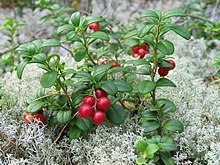
Back المنطقة السيركومبوريالية Arabic Regió circumboreal Catalan Cirkumboreální oblast Czech Región Circumboreal Spanish منطقه پیراشمالی FA Sirkumboreaalinen alue Finnish Région circumboréale French Циркумбореален регион MK Circumboreaal Dutch Sirkumboreal utbreiing NN
This article needs additional citations for verification. (March 2009) |





The Circumboreal Region in phytogeography is a floristic region within the Holarctic Kingdom in Eurasia and North America, as delineated by such geobotanists as Josias Braun-Blanquet and Armen Takhtajan.
It is the largest floristic region in the world by area, comprising most of Canada, Alaska, Europe, Caucasus and Russia, as well as North Anatolia (as the southernmost part of the region) and parts of northern New England, Michigan, Minnesota, Wisconsin, and the Turtle Mountains of North Dakota. Northern portions of the region include polar desert, taiga[1] and tundra biomes. Many geobotanists divide Eurasian and North American areas into two distinct regions. The continents, however, share much of their boreal flora (e.g. Betula nana, Alnus viridis, Vaccinium vitis-idaea, Arctostaphylos uva-ursi). The flora was severely impoverished during glaciations in the Pleistocene. The region is bordered by Eastern Asiatic, North American Atlantic, Rocky Mountain, Mediterranean and Irano-Turanian Regions.
There are no biological families endemic to this region, but it has endemic genera (e.g. Lunaria, Borodinia, Gorodkovia, Redowskia, Soldanella, Physospermum, Astrantia, Thorella, Pulmonaria, Erinus, Ramonda, Haberlea, Stratiotes, Telekia) and many endemic species, especially in the mountains.
- ^ C.Michael Hogan. 2011